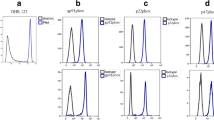Abstract
The polymorphonuclear (PMN) cells from a patient with cytochrome b positive X-linked chronic granulomatous disease (Xb+CGD) were studied using flow cytometry. Both the cell surface expression of monoclonal antibody defined cytochrome b and the superoxide production (intracellular 2′, 7′-Dichlorofluorescin Diacetate oxidation) were investigated at a single cell level. Flow cytometry clearly demonstrated the complete absence of superoxide production in the patient's PMN cells, the mosaicism in his mother's PMN cells and also indicated the normal cell surface expression of cytochrome b. The results obtained by Western blot analysis and reduced-minus-oxidized spectra confirmed the presence of functional and normal amounts of cytochrome b. We concluded that this is a case of Xb+CGD with a normal cell surface expression of cytochrome b.
Similar content being viewed by others
Abbreviations
- CGD:
-
chronic granulomatous disease
- NBT:
-
nitroblue tetrazdium
- PMN:
-
polymorphonuclear
- Xb+:
-
X-linked cytochrome b positive
References
Ament ME, Ochs HD (1973) Gastrointestinal manifestation of chronic granulomatous disease. N Engl J Med 288:382–387
Babior BM (1988) The respiratory burst oxidase. Hematol Oncol Clin North Am 2:201–212
Babior BM, Kuver R, Curnutte JT (1988) Kinetics of activation of the respiratory burst oxidase in a fully soluble system from human neutrophils. J Biol Chem 263:1713–1718
Baehner RL, Nathan DG (1968) Quantitative nitroblue tetrazolium test in chronic granulomatous disease. N Engl J Med 278:971–976
Bass DA, Parce JW, Dechatelet LR, Szeijda P, Seeds MC, Thomas M (1983) Flow cytometric studies of oxidative product formation by neutrophils: A graded response to membrane stimulation. J Immunol 130:1910–1917
Borregaard N, Johansen KS, Esmann V (1979) Quantitation of superoxide production in human polymorphonuclear leukocytes from normals and 3 types of chronic granulomatous disease. Biochem Biophys Res Commun 90:214–219
Clark RA, Malech HL, Gallin JI, Nunoi H, Volpp BD, Pearson DW, Nauseef WM, Curnutte JT (1989) Genetic variants of chronic granulomatous disease: prevalence of deficiency of two cytosolic components of the NADPH oxidase system. N Eng J Med 321:647–652
Curnutte JT (1988) Classification of chronic granulomatous disease. Hematol Oncol Clin North Am 2:241–252
Dinauer MC, Orkin SH, Brown R, Jesaitis AJ, Parkos CA (1987) The glycoprotein encoded by the X-linked chronic granulomatous disease locus in a component of the neutrophil cytochrome b complex. Nature 327:717–720
Dinauer MC, Curnutte JT, Rosen H, Orkin SH (1989) A missense mutation in the neutrophil cytochrome b heavy chain in cytochrome-positive X-linked chronic granulomatous disease. J Clin Invest 84:2012–2016
Hjorth R, Jonsson AK, Vreblad P (1981) A rapid method for purification of human granulocytes using Percoll. A comparison with dextran sedimentation. Immunol Method 43:95–101
Lehrer RI, Ganz T, Selsted ME, Babior BM, Curnutte JT (1988) Neutrophils and host defense. Ann Intern Med 109:127–142
McPhail LC, Shirley PS, Clayton CC, Snyderman R (1985) Activation of the respiratory burst enzyme from human neutrophils in a cell-free system: evidence for a soluble cofactor. J Clin Invest 75:1735–1739
Mizuno Y, Hara T, Nakamura M, Ueda K, Minakami S, Take H (1988) Classification of chronic granulomatous disease on the basis of monoclonal antibody-defined cytochrome b deficiency. J Pediatr 113:458–462
Nakamura M, Sendo S, Zwieten RZ, Koga T, Roos D, Kanegasaki S (1988) Immunocytochemical discovery of the 22- to 23-Kd subunit of cytochrome b558 at the surface of human peripheral phagocytes. Blood 72:1550–1552
Ochs HD, Igo RP (1973) The NBT slide test: a simple screening method for detecting chronic granulomatous disease and female carriers. J Pediatr 83:77–82
Ohno Y, Buescher ES, Roberts R, Metcalf JA, Galin JI (1986) Reevaluation of cytochrome b and flavin adenine dinucleotide in neutrophils from patients with chronic granulomatous disease and description of a family with probable autosomal recessive inheritance of cytochrome b deficiency. Blood 67:1132–1138
Okamura N, Malawista SE, Roberts RL, Rosen H, Ochs HD, Babior BM, Curnutte JT (1988) Phosphorylation of the oxidase-related 48K phosphoprotein family in the unusual autosomal cytochrome-negative and X-linked cytochrome-positive types of chronic granulomatous disease. Blood 72:811–816
Parkos CA, Allen RA, Cochrane CG, Jesaitis AJ (1987) Purified cytochrome b from human granulocyte plasma membrane is composed of two polypeptide with relative molecular weights of 91,000 and 22,000. J Clin Invest 80:732–742
Parkos CA, Allen RA, Cochrane CG, Jesaitis AJ (1988) The quarternary structure of the plasma membrane b type cytochrome of human granulocytes. Biochim Biophys Acta 932:71–83
Parkos CA, Dinauer MC, Walker LE, Allen RA, Jesaitis AJ, Orkin SH (1988) Primary structure and unique expression of the 22-kilodalton light chain of human neutrophil cytochrome b. Proc Natl Acad Sci USA 85:3319–3323
Rosen H, Klebanoff SJ (1976) Chemiluminescence and superoxide production by myeloperoxidase-deficient leukocytes. J Clin Invest 58:50–60
Royer-Pokora B, Kunkel LM, Monaco AP, Doff SC, Newburger PE, Baehner RL, Cole FS, Curnutte JT, Orkin SH (1986) Cloning the gene for an inherited human disorder — chronic granulomatous disease — on the basis of its chromosomal location. Nature 322:32–38
Segal AW (1987) Absence of both cytochrome b−245 subunits from neutrophils in X-linked chronic granulomatous disease. Nature 326:88–91
Author information
Authors and Affiliations
Rights and permissions
About this article
Cite this article
Azuma, H., Oomi, H., Ueda, D. et al. Cytochrome b positive X-linked chronic granulomatous disease: A normal cell surface expression of cytochrome b. Eur J Pediatr 151, 279–282 (1992). https://doi.org/10.1007/BF02072229
Received:
Accepted:
Issue Date:
DOI: https://doi.org/10.1007/BF02072229




